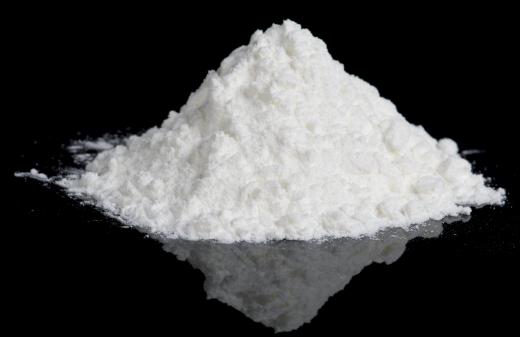What is Calcium Carbonate?
 Michael Anissimov
Michael Anissimov
Calcium carbonate is an important chemical compound made up of one atom of calcium bonded to one atom of carbon and three atoms of oxygen. Its molecular formula is CaCO3. Common names for this compound include limestone, calcite, aragonite, chalk, and marble, and while all contain the same substance, each has different processes underlying its formation. Calcium carbonate is used in cements and mortars, producing lime, in the steel industry, glass industry, and as an ornamental stone.
This compound usually looks like a white powder or stone. It will fizz and release carbon dioxide upon contact with a strong acid, such as hydrochloric acid. After the carbon dioxide is released, the remainder is calcium oxide (CaO), commonly called quicklime.

When calcium carbonate comes into contact with water saturated with carbon dioxide, it forms a soluble compound, calcium bicarbonate. Underground, this often leads to the formation of caves. The reaction is as follows:
CaCO3 + CO2 + H2O → Ca(HCO3)2
Calcium carbonate becomes marble when highly compressed and heated deep underneath the Earth’s surface. In caves, when dissolved by the above chemical mechanism, it creates magnificent speleothems: cave formations such as stalagmites, stalagmites, curtains, and dozens of others. There are many mineral formations characteristic of this compound, but one of the most common forms is the scalenohedron, or “Dogtooth Spar,” for its resemblance to the canine tooth of a dog.

In the form of calcite, this material has an interesting optical property: double refraction. This occurs when a ray of light enters the crystal and splits into distinct fast and slow beams. When an observer looks through the crystal, he or she sees two images of everything behind it.
Calcium carbonate possesses other unusual properties, such as fluorescence and triboluminescence. This means that, when combined with a small amount of manganese and put under a UV light, it glows bright red. Under some conditions, the glow even persists when the UV light is removed. Triboluminescence, the property of demonstrating light when pieces of crystal are struck against each other, is more difficult to demonstrate, but it has been noted.
AS FEATURED ON:
AS FEATURED ON:















Discussion Comments
Is it possible to remove the calcium carbonate in hard water by precipitating it out of solution and then physically removing it? I have water that is over 100 grains hard and I am currently using a lot of salt to soften it. I wondered if there was a better solution.
Is Calcium carbonate alone UV absorbing?
I've heart calcium carbonate can be used for soil erosion. How does that work? How does it compare with the use of straw and excelsior (wood fiber)? Also, would it be advantageous to use calcium carbonate for soil erosion in arid regions where there is little chance of establishing grass or other vegetation?
@ COmparables- I can help you out. Acid rain (carbonic acid H2CO3) is simply carbon dioxide (CO2) dissolved in water (H2O). Carbon dioxide gas dissolves into the water vapor in the clouds and falls to the ground as a slightly acidic solution. Acid rain is not a new phenomenon it has been falling to earth since life has existed. The acid rain has just become more acidic since the industrial revolution, so the controversy surrounding acid rain is about the increased acidity due to anthropogenic causes. In the 660,000 years before the industrial revolution, carbon concentrations in the atmosphere have never exceeded 350 parts per million.
Under current conditions, dissolution of calcium carbonate and the precipitation of calcium bicarbonate back to calcium carbonate would simply be accelerated. Caves would form faster, stalactites would hang down further, and stalagmites would reach higher towards the roof of caves.
@ Highlighter- If acid rain dissolves calcium carbonate then why are most of these caves thousands of years, if not millions of years, old? Isn't acid rain a fairly recent phenomenon? If you can explain this a little more I would appreciate it.
The chemical process of calcium carbonate precipitation is what forms the many of the caves, stalactites, and stalagmites that you see below the earth’s surface. The dissolution of the calcium carbonate in by carbonic acid (acid rain) causes the calcium carbonate to form a solution. The dissolution of calcium carbonate forms the caves and caverns underground.
This dissolved calcium carbonate forms calcium bicarbonate, which then precipitates out of solution to become an insoluble solid (it is only soluble in a carbonic acid, not pure water). This precipitation is what forms the stalactites and stalagmites that form within caves (and the lime scale around your bathtub that is so hard to scrub off). The interesting thing about this chemical process is that the precipitate becomes more stable at colder temperatures because there is less carbon dioxide dissolved in the water.
Post your comments